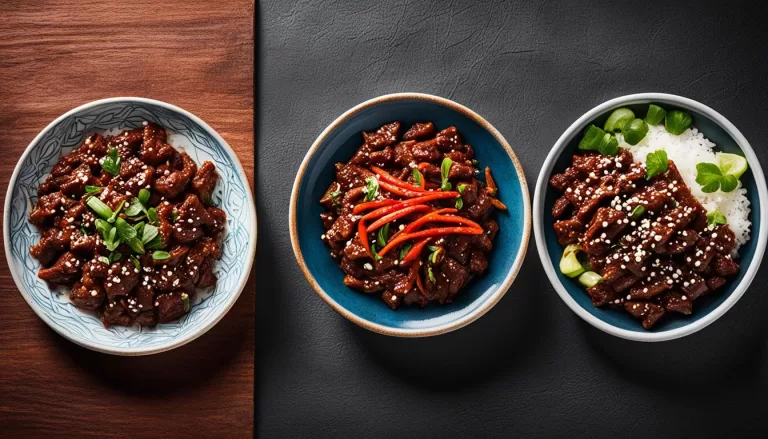Authentic Homemade Cantonese Steamed Fish Recipe – The Perfect Healthy Dinner Option

Selecting the Fresh Fish
Now that you’ve learned crucial background information about Cantonese Steamed Fish, let’s move onto a significant step—choosing the right fish. Freshness is paramount! Without a fresh fish, you’re not fully experiencing the dish.
Ideally, go for saltwater fish like sea bass, flounder, or halibut. But don’t fret if they’re not available. Tilapia or catfish could work too!
Origin Matters
Where’s your fish from? It matters. Local, wild-caught fish is your best bet over the farm-raised versions. The reason? Wild fish eat a natural diet, which translates to better taste and texture. But if you’re landlocked and limited to the supermarket selection, don’t sweat it. You’re still going to create a delightful dish!
Fresh Fish Characteristics
How do you tell apart fresh fish from the not-so-fresh ones? Here are some quick checks:
- Eyes: Fresh fish have clear, bright eyes. Steer clear of fish with cloudy, sunken eyes.
- Gills: Look for gills that are rich, red, or pink. Avoid fish with brown or dull-colored gills.
- Smell: Fresh fish smells briny like the sea. If you detect an overly fishy or foul smell, it’s a no-go.
Remember, don’t compromise on quality. Your dish is only as good as your key ingredients.
In the next section, we’ll delve into preparing your fresh fish for cooking. Stay tuned to navigate through the process easily.
Preparing the Ingredients

You’ve selected your fresh, perfect fish—it’s now time to gather and prep the remaining ingredients. This journey begins in your very own kitchen.
Gathering Your Ingredients
Our recommended Cantonese Steamed Fish Recipe requires:
| Ingredients | Quantity |
|---|---|
| Fish (Sea Bass, Flounder) | 1, whole |
| Fresh Ginger, thinly sliced | 4-5 slices |
| Green Onions, cut into strips | 3 |
| Fresh Cilantro, finely chopped | A handful |
| Light Soy Sauce | 3-4 tbsp |
| Sesame Oil | 1 tbsp |
| White Pepper | A pinch |
Ingredient Alternatives
Having ingredient alternatives is always a good idea. If Sea Bass or Flounder isn’t available, you can replace it with Tilapia or Trout. Dark soy sauce adds an unfamiliar depth to the sauce, in lieu of light soy sauce, if you’re feeling adventurous.
Nutritional Value
Homemade Cantonese Steamed Fish is a low-fat, high-protein dish excellent for your health regimen. Here’s what you’ll gain from the dish:
| Nutrient | Quantity (per serving) |
|---|---|
| Calories | 200 |
| Carbs | 6g |
| Protein | 45g |
| Fat | 3g |
| Vitamin B12 | 100% of daily value |
Preparing Ingredients for Cooking
To prepare, begin with the fish. Clean it thoroughly to maintain the fresh, briny flavor. For the accompaniments, thinly slice the ginger, cut the green onions into long strips, and finely chop the fresh cilantro.
Seasoning the Fish

After prepping your ingredients, it’s down to the nitty-gritty – seasoning your fish. Here’s how you’ll do that.
Firstly, grab two tablespoons of finely chopped ginger. Rub this all over the fish. Ginger’s gentle heat and peppery flavor gives an aromatic edge, soaking into the fish’s flesh. Then take two of your pre-sliced scallions and all of your cilantro. Stuff these into the fish cavity, ensuring it’s evenly spread. This stuffing will infuse a zesty, herbal note. Not a fan of cilantro? No problem. Try lemongrass or basil, they’ll offer a refreshing punch.
A cheeky tip for you: let the fish sit for about 15 minutes after your initial seasoning. This resting period allows spices to steep into the fish.
Now onto the sauce. In a bowl, mix 4 tablespoons soy sauce with one tablespoon of sesame oil. You could jazz it up by adding a hint of chili or crushed garlic. Sepia-toned dark soy sauce offers a softer, sweeter note, while light soy sauce provides a saltier kick. Feeling experimental? Use a blend of both. Pour this sauce on the fish just before you steam it. Ladle it evenly, covering all areas.
For the last touch, sprinkle a pinch of white pepper. This isn’t just for heat. It adds a subtle, layered spice, enhancing those lovely flavors without overpowering them.
You’re now one step closer to serving a show-stopping Cantonese Steamed Fish dish. Your kitchen will soon be wafting with an array of sumptuous aromas from the melting pot of flavors. Are you ready to move on, and step into the world of steaming the fish?
Steaming the Fish

Initiating the Steaming Process
Next up is the steaming phase. But before that, you’ll need a bamboo steamer. This traditional tool will bring authenticity to your dish. If you’re asking where to find it, your local oriental store should hold it, or an online marketplace will do the trick too!
Time to put that bamboo steamer to work. Make sure there’s enough water in your wok, or any large pot, for a thorough steam. Bring it to a boil. Gently set your fish in the steamer, keeping it in the middle which provides equal heating.
Ensuring Perfect Steam Time
Giving the right time for your fish to steam is critical. The rule of thumb? For every inch of thickness, your fish adoringly spends ten minutes in the steamer. Remember, oversteaming can make your fish lose its delicate texture, while under-steaming risks the raw taste persisting.
| Thickness of Fish | Steaming Time |
|---|---|
| 1 inch | 10 minutes |
| 2 inches | 20 minutes |
Spicing it Up
Halfway through steaming, remember to drizzle some hot oil over the fish. It’s a technique not everyone knows, but it enhances the flavors incredibly. And then sprinkle your heart out with scallions, garlic, and chilies (if you’re up for a kick!).
Nutritional Value
By the way, for those of you mindful of nutrition values, here’re some facts about this recipe. Steamed fish is low-calorie, high-protein, and full of heart-healthy Omega-3 fatty acids. It’s delicious and nutritious!
| Nutrient | Value |
|---|---|
| Calories | Low |
| Protein | High |
| Omega-3 | High |
Serving the Steamed Fish

Now that your mouthwatering Cantonese Steamed Fish is nearly ready, you’ll want to know the best way to serve it up. Serving this exotic dish isn’t as simple as sliding it onto a plate. The right presentation can make all the difference in the world to your dining experience.
Steamed fish really shines when served straight from the steamer. Do not allow the fish to cool or the skin to dry out. The magic is in how moist and tender the fish comes out of the steamer. Ensure it maintains its heat and moisture by serving it quickly.
While plating, elevate your dish with some vegetable garnish. Some colorful bok choy or vibrant snow peas can add an eye-catching contrast to the fish. Presentation is key. A little care in how your dish looks can transform the simplest meal into a gourmet dining experience.
Your interactively spiced Cantonese steamed fish is best paired with white rice or noodles. These sides help soak up the flavorsome juices shared in the steaming process. Pair your dish with a crisp and accompanying white wine like Riesling. The subtle sweetness of Riesling helps to balance the heat of the chili and the robust flavors of garlic and scallions.
Dive right in! Feel free to enjoy your Cantonese Steamed Fish with chopsticks, a fork or even your hands, if that’s your style. Remember, there’s no wrong way to savor this. The custom is to first enjoy the top part of the fish before gently flipping it to feast on the other side. Do watch out for bones!
Some additional tips for those who have dietary considerations or unique tastes:
- Substitute any white fish like cod or halibut if you can’t source the traditional type.
- If you’re watching your calories, reduce the oil in the recipe or even consider a spritz of olive oil spray.
- Feel free to experiment with the garnish. Have a go with some radishes, julienne carrots or fresh cilantro for a unique zest to your dish!
This is your chance to savor the authentic taste of Cantonese cuisine. Steamed fish is an exemplary dish that speaks to the core values of Cantonese cookery – freshness, lightness and balance.
Conclusion
Now you’ve got all the tips and tricks up your sleeve to perfect that Cantonese Steamed Fish dish. It’s all about maintaining that moist texture and presenting it fresh from the steamer. Don’t forget to garnish with vegetables to make it visually appealing. Whether you pair it with white rice or noodles, or even a glass of crisp Riesling, you’re in for a delightful dining experience. Remember, you can always mix it up with different garnishes and dietary substitutions. This dish truly encapsulates the authentic taste of Cantonese cuisine with its freshness, lightness, and balance. So go ahead, put on that chef’s hat, and give this recipe a try. Your taste buds are in for a real treat!





